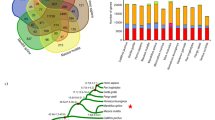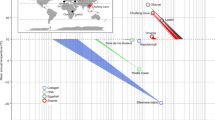Abstract
A CONVINCING theory of human origins must clarify man's relationships with living primates and with the ancestral forms known only through fossils. Phylogenetic relationships have previously been determined mainly by anatomical similarities, but now, biochemical similarities provide independent criteria for evolutionary relationships. Albumin and transferrin immunology, immunodifrusion, DNA annealing and amino acid analysis all indicate that chimpanzees, gorillas and humans share a substantial common ancestry, and that the Asiatic apes (gibbons and orangutans) diverged earlier from this lineage1–3. These findings directly conflict with the more widely held view that all the great apes diverged from a common ancestor long after the ‘Origin’ of the evolutionary line leading to modern humans4. The molecular data consistently suggest a much more recent origin of the man–chimpanzee–gorilla separation than was previously imagined, namely, in the range of 4–6 M yr ago3,5. These data show that, although the two chimpanzee species (Pan paniscus and P. troglodytes) are biochemically distinct, they are more closely related to each other than either is to humans or gorillas6,7. The chimpanzees speciated, then, after the initial three-way split. We therefore, here contend that, among living species, the pygmy chimpanzee (P. paniscus) offers us the best prototype of the prehominid ancestor. Biochemical, morphological, behavioural and palaeontological data support this proposition and argue for a relatively recent and accelerated divergence of the hominid from the pongid line.
This is a preview of subscription content, access via your institution
Access options
Subscribe to this journal
Receive 51 print issues and online access
$199.00 per year
only $3.90 per issue
Buy this article
- Purchase on Springer Link
- Instant access to full article PDF
Prices may be subject to local taxes which are calculated during checkout
Similar content being viewed by others
References
Goodman, M. in Molecular Anthropology (eds Goodman, M. & Tashian, R. E.) 321–353 (Plenum, New York, 1976).
Benveniste, R. E. & Todaro, G. T. Nature 261, 101–108 (1976).
Sarich, V. M. & Cronin, J. E. in Molecular Anthropology (eds Goodman, M. & Tashian, R.E.) 141–170 (Plenum, New York, 1976).
Delson, E. & Andrews, P. in Phytogeny of the Primates (eds Luckett, W. P. & Szalay, F. S.) 405–446 (Plenum, New York, 1975).
Sarich, V. M. & Cronin, J. E. Nature 269, 354 (1977).
Goodman, M., Moore, G. W., Farris, W. & Poulik, E. in The Chimpanzee Vol. 2, 318–360 (Karger, Basel, 1970).
Cronin, J. E. Am. J. phys. Anthrop. 47, 125 (1977).
Zihlman, A. L. & Cramer, D. L. Folia primat. 29, 86–94 (1978).
Cramer, D. L. Craniofacial Morphology of Pan paniscus Contrib. Primat. No. 10 (Karger,Basel, 1977).
Cramer, D. L. & Zihlman, A. L. Rec. Adv. Primatol. 3, 487–490 (1978).
Johanson, D. C. Am. J. phys. Anthrop. 41, 39–48 (1974).
Badrian, A. & Badrian, N. Oryx 13, 464–468 (1977).
Kano, T. in Perspectives on Human Evolution Vol. 5 (eds Hamburg, D. A. & McCown, E.R.) (Benjamin/Cummings, Menlo Park, in the press).
Savage, S. & Bakeman, R. Rec. Adv. Primatol. 1, 613–616 (1978).
Savage-Rumbaugh, E. S., Wilkerson, B. J. & Bakeman, R. in Progress in Ape Research (ed.Bourne, G.) 97–116 (Academic, New York, 1977).
Jordan, C. & Jordan, H. Primates 18, 515–529 (1977).
Leakey, M. D. et al. Nature 262, 460–466 (1976).
Johanson, D. C. & Taieb, M. Nature 260, 293–297 (1976).
Aronson, J. L. et al. Nature 267, 323–327 (1977).
Zihlman, A. L. Am. J. phys. Anthrop. 47, 169 (1977).
Holloway, R. L. in Functional and Evolutionary Biology of Primates (ed. Tuttle, R. H.)185–203 (Aldine, Chicago, 1972).
King, M. C. & Wilson, A. C. Science 188, 107–116 (1975).
Lovejoy, C. O. in Primate Functional Morphology and Evolution (ed. Tuttle, R. H.) 291–326 (Mouton, The Hague, 1975).
Author information
Authors and Affiliations
Rights and permissions
About this article
Cite this article
ZIHLMAN, A., CRONIN, J., CRAMER, D. et al. Pygmy chimpanzee as a possible prototype for the common ancestor of humans, chimpanzees and gorillas. Nature 275, 744–746 (1978). https://doi.org/10.1038/275744a0
Received:
Accepted:
Issue Date:
DOI: https://doi.org/10.1038/275744a0
This article is cited by
-
Bonobo anatomy reveals stasis and mosaicism in chimpanzee evolution, and supports bonobos as the most appropriate extant model for the common ancestor of chimpanzees and humans
Scientific Reports (2017)
-
Cognitive Functions: Human vs. Animal – 4:1 Advantage |-FAM72–SRGAP2-|
Journal of Molecular Neuroscience (2017)
-
Using primate models to study the evolution of human locomotion: concepts and cases
BMSAP (2014)
Comments
By submitting a comment you agree to abide by our Terms and Community Guidelines. If you find something abusive or that does not comply with our terms or guidelines please flag it as inappropriate.



